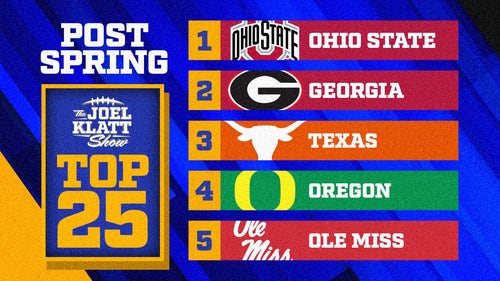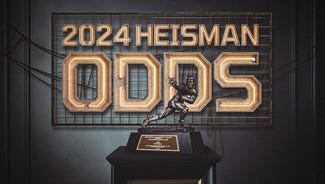
College football's bowl system is thriving, with or without some of its stars
BOCA RATON, Fla. — Baylor star tailback Shock Linwood joined Stanford’s Christian McCaffrey and LSU’s Leonard Fournette in leaving his team prior to their bowl game. In each case, the players chose NFL preparation over the risk of potential injury.
The flurry of decisions from high profile players certainly marks the distinct start of a trend for college stars and the postseason. Everyone can agree on that. Starting next season, when a star player on a decent team approaches the postseason, he’ll inevitably have a decision to make about playing in the bowl game. From there, opinions get muddled.
Are the players selfish or pragmatic? Are they securing their future or abandoning their teams? Is lining up with your friends and teammates one more time worth the risk of being a cautionary tale?

Those are thorny questions with no clear answer, the kind that can drive hours of talk radio in the way that WakeyLeaks and Deflategate can. That’s why we can welcome this new dilemma into our news cycle for perpetuity.
But there’s one reaction to this flurry of decisions that’s been a bit baffling. There’s been too much projecting that these high-profile defections will lead to some sort of decline in the bowl system.
ESPN’s Adam Schefter reacted to the news McCaffrey won’t play in the Sun Bowl by saying: “I think we’ve begun to see the collapse of the bowl system at the college level for big-time college players.” My friend and former colleague Stewart Mandel opined: “We may one day look back at McCaffrey’s and Fournette’s decisions as a key moment in college football’s transformation from bowl era to playoff era.”
The counter argument to the “demise of the bowl” takes—and there were plenty others—played out at a place both strange and fitting on Tuesday night. The third incarnation of the immortal Boca Raton Bowl—Western Kentucky’s 51–31 blowout of Memphis—offered evidence all around FAU Stadium as to why the bloated college bowl system isn’t threatened or changing. If anything, it’s going to continue to grow and prosper.
Outside the stadium on a humid evening, the proliferation of sponsor tents and people hawking goods made it feel like a flea market popped up around the stadium. There were booths for organic juices, a woman handing out red Tire Kingdom koozies and a Coke truck (unfortunately) blasting “Uptown Funk.” And there was, of course, a tent for a local ESPN Radio station, ESPN Deportes and an ESPN VIP party to thank all the sponsors.
If there was a soundtrack to all this, it would have been a cash register ringing in perpetuity. And this is the Boca Raton Bowl, which didn’t have a title sponsor this year. Imagine the corporate money printing at the marquee bowls in bigger stadiums with better match-ups in bigger cities?

That corporate sprawl offered another reminder—if you needed one—just how much cash is at stake. There’s a reason ESPN televises 38 of the 41 games and owns and operates 13 of them. There’s a reason that 27 of the 41 bowl games didn’t exist 30 years ago.
In a suite high above FAU Stadium during the second quarter, American Athletic Conference commissioner Mike Aresco recalled his time as an executive at CBS when they televised an Indiana-Butler game in 2012 that ended in an overtime upset of the No. 1 Hoosiers. Aresco was thrilled until he saw the Gildan New Mexico Bowl—between Arizona and Nevada—crush it in the ratings by 1.9 to 1.5. “That’s when I realized,” he said, “football had become king.”
Three years ago, that juggernaut linked arms with the College Football Playoff, a move that further muted any bowls that aren’t tied to the three playoff games. Before McCaffrey decided he wouldn’t play in the Sun Bowl, few people knew who was playing in the Sun Bowl anyway. (Stanford plays North Carolina). The trend hasn’t shaken the core bowl establishment, as Orange Bowl CEO Eric Poms said: “I don’t know if there’s enough time to understand if there’s something there.”
The most interesting perspective on the Great Bowl Debate of 2016 came from new Western Kentucky coach Mike Sanford. He understands all sides of the issues because he’s lived them. As an assistant at Stanford, he recruited McCaffrey. As an assistant at Notre Dame last year, he watched Jaylon’s Smith horrific leg injury in the Fiesta Bowl that’s the defining cautionary tale for not playing in bowl games. (Smith still hasn’t returned, his draft stock slipped from top five to second round where the Cowboys snagged him).
“To condemn that type of decision or to pressure them not to make it, that’s a lose-lose scenario,” Sanford said. “You need to respect the fact they have a future and a chance to have a lucrative career in professional football. The athletes are not a property of the university.”
Ultimately, the impact of these decisions don’t project to have more far reaching ramifications than filling some news cycles every year. The bowl system may be cumbersome and confusing, as they change names like Jason Bourne changes passports.
But bowl games have undeniably become the December background noise at your company holiday party, your December treadmill sprints and those cold nights when the Potato Bowl is more comforting than leaving the couch. Americans like watching football, as evidence by the 2015 Russell Athletic Bowl—between non-traditional powers Baylor and North Carolina—doing the same rating (2.6) as the top-rated regular season college basketball (UNC-Duke) last year. The December bowl orgy is annually one of the most flush ratings runs for ESPN every year. What’s the most players who could sit out the postseason? A dozen? That’s not going to change anything.
And if you think they’ll be less bowl games, consider that a conference source told Sports Illustrated there’s “at least 10 cities” vying to add bowl games. When the current non-playoff bowl contracts expire in 2019, cities like Little Rock, Austin, Myrtle Beach and Charleston want to get in the mix. “I don’t think a couple of guys deciding not to play in mid-level bowl games will threaten the system,” Aresco said. “But will we see more of that? We might.”
The game here on Tuesday night was a relatively mundane affair, at least for a game with 82 points. Western Kentucky won with interim coach Nick Holt, who called it a “dream come true.” WKU star lineman Forrest Lamp—himself a projected draft choice—answered a question about the past few years of WKU success by saying, “There’s nothing that’s compared to it in my life.” Even the losing coach, Memphis’s Mike Norvell, raved about the opportunity: “The bowl system is one of the greatest things about college football. It’s a reward.”
Bowls may be mocked on the outside, but they’re watched by millions and embraced by the participants. A few guys protecting themselves and sitting out games won’t significantly change any of that. Any gloom-and-doom prognosticators should exhale and grab a stiff drink. Feel free to slip it into a Tire Kingdom koozie to keep it cold and remind you why all these bowls exist in the first place.



